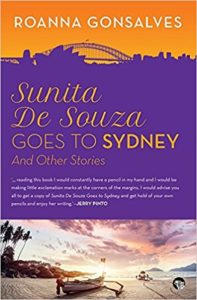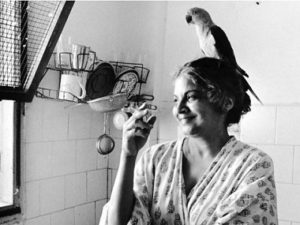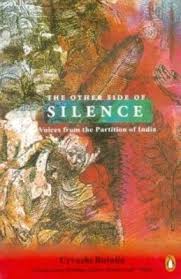An interview with Roanna Gonsalves
 Roanna Gonsalves is from India. She earned her PhD from the University of New South Wales. She teaches creative writing workshops within communities, schools, and universities. Her research focuses on the arts, social media, creativity studies and postcolonial literatures. She created a series of radio documentaries entitled, On the Tip of a Billion Tongues. She received the Prime Minister’s Australia Asia Endevour Award. She is the co-founder and co-editor of Southern Crossings. She is the author of The Permanent Resident, which won 2018 NSW Premier’s Literary Awards, Multicultural NSW Award.
Roanna Gonsalves is from India. She earned her PhD from the University of New South Wales. She teaches creative writing workshops within communities, schools, and universities. Her research focuses on the arts, social media, creativity studies and postcolonial literatures. She created a series of radio documentaries entitled, On the Tip of a Billion Tongues. She received the Prime Minister’s Australia Asia Endevour Award. She is the co-founder and co-editor of Southern Crossings. She is the author of The Permanent Resident, which won 2018 NSW Premier’s Literary Awards, Multicultural NSW Award.
****
Sunita De Souza goes to Sydney is a powerful set of stories that are atmospheric. Packed with detailed descriptions of Bombay/ Mumbai, Goa and Australia. “Home stays with you, in your stories” is a beautifully apt description of immigrant literature coined by by Norwegian resident, originally from Nagaland, and the Sahitya Akademi Bal Puraskar 2018 winner, Easterine Kiralu. The comment encapsulates Roanna Gonsalves short stories very well too.
It is not clear if the principle of arrangement of the stories is chronological but there is definitely a shift in the confident writing style and evolution of the women characters from the first “Full Face” to the last “The Permanent Resident”. There is a quiet determination evident in the stories to make literature out of the most ordinary experiences such as in the search for Sichuan peppercorns to prepare Kung pa khao chicken for lunch in “Easter 2016”. This is a devastatingly sharp story beginning with the title which is so apt with its double-edged reference to the resurrection of Christ and that of the woman narrator occurring on Easter Sunday. Roanna Gonsalves captures the relationship between her husband, Ronnie, and the narrator so well especially his insistence for Sichuan peppercorns No substitution with Indian peppercorn would suffice. His steely stubbornness that he wanted a change in the menu despite the fact the Easter Sunday lunch had already been cooked. The exhausted wife (not just physically but mentally and emotionally for being stuck in domestic drudgery and childcare, reminiscing about her life back in Bombay when she could also be a professional) agrees to look for the spice even though it is the long Easter weekend and in all likelihood all provision stores would be shut. The descriptions of the people walking on the streets as she goes by in her search is as if a bird has been let out of its cage and watches in numb wonderment. The narrator observes everyone so closely; as if the boundary lines between the narrator and author are blurred at this point. When she finally finds a store open, discovers a packet of the spice, nothing prepares the reader for her defiant act of tearing open the packet of pink peppercorns that are “pink as the sky at dusk over the backwaters of the Mandovi”, munching them and leaving the open packet on the shelf and walking out for a stroll reminiscing on how the fragrance reminds her of her grandmother while the flavour is that of a combination of lavender and Tiger Balm. The story works marvellously well at so many levels!
The dark twist of “Christmas 2012” is gut wrenching. “What you understand you can control” seems so innocuous a statement at first and then comes the story’s conclusion. I found myself holding my breath and was sickened to the core when I finished reading. It is a dark secret of many households even now if one keeps track of child sexual abuse stories. The horror of it is magnified by watching the news of the shocking rape of Dec 2012 but it seems to have no impact on the father. I cannot get over the image of the bossy Martha, fussing over the linen and cutlery and carving of the turkey, being so precise about the Turkey sauce blemish on the white tablecloth; she knows exactly what home remedy to fix the stain but is clueless on how to “fix” the moral stain on her family. The poor woman stuck in a new land as an immigrant has no one really to speak to and cannot in any way jeopardise her situation or that of her husband by reporting Martin to the police otherwise they will in all likelihood lose their PR (Permanent Resident) status. Hell truly exists on earth and it is usually of man’s own making.
The stories are full of very distinct characters, particularly the women. Usually in a short story collection the danger always exists of the personality of the characters blending into each other and acquiring a monotonous tone. This is not the case for Sunita de Souza. With the women characters, the author explores situations and how far can women push their limits. It’s as if they have always had an urge to explore but were boxed in by social rules of conduct back home in India. Whereas being on one’s own in a new land provides an anonymity that pushes one to the brink to discover new spaces — physically and metaphorically too. Driven to extreme situations the women unexpectedly find their voices and take a stand. It is not as if they were weaklings in the first place, they just conform and conform. Then something clicks and they take flight in a good way. They take decisions that change their lives for the better. For instance, the protagonists of “(CIA) Australia”, “Full Face” and “Teller in the Tale” or even the “bold” mother in “Soccer Mum”. All the women try, some do take action and others contemplate it and in the process provide a role model to the readers.
The strongest stories in this collection to my mind are “The Dignity of Labour”, “Easter 2016” and “The Permanent Resident”. The themes of domestic violence, fragile male egos/ patriarchal sense of entitlement that the men exhibit and assertion of the individual’s identity are not new and never will be but come together ever so stunningly in these stories. These are horrendous stories for the violence highlighted. While reading these three stories I could not help but recall the commandment “Love thy neighbour as thyself”. The focus is inevitably on the first half of the commandment but increasingly I feel that women in particular should also learn to focus on the second half — self-preservation is equally critical. Don’t always give and give, but learn to maintain your dignity, self-respect, identity. The sleazy story “Up Sky Down Sky Middle Water” captures this commandment well. The girl was very sure she did not want to be a one-night stand but in that short ride she had done her calculation that having sex with the guy by the roadside would in all likelihood give her an advantage in negotiating her salary. It is a very unsettling story but in it lies quite a remarkable tale of self-preservation. She is near starvation with a very low bank balance and she has to do the quick calculation of whether using her body will give her an added advantage. It is tough to decide whether one passes moral judgement on the girl or appreciates her boldness, her quick thinking to be in some ways emotionally detached from the scene and think ahead of her future. The reader is put in quite a spot with this story.
The phrase “family friendly feminism” is fast becoming fashionable which is annoying for a variety of reasons but as your stories show there is so much work left to be done. Though the stories focus upon experiences of immigrants, specifically within the Goan/Bombay Catholic community, there is a universal truth embedded in every single story.
Fantastic collection!
****
Here are excerpts of an interview with the author:
- How long were these stories in the making?
I took about five years to write these stories, but they are standing on over two decades of writing experience. My first job after graduating from St. Xavier’s College in Mumbai was as a reporter with Screen, in India, back in the days when it was a broadsheet. Since then I have written journalism, literary nonfiction, blogs, scholarly pieces in international peer-reviewed journals, radio documentaries, including Doosra: The Life and Times of an Indian Student in Australia and On the tip of a Billion Tongues, a four part radio documentary series on contemporary multilingual Indian writing. I’ve written for the stage and had short fiction published in different journals, and anthologised in collections. I also wrote a novel (unpublished) which was longlisted for the Vogel Awards, back when I was under 35, which is the cut-off age for that award. As they say, you have to write millions of terrible words before you get to the good words. So all of this writing needed to be done, over two decades, before I could write my book. It took this long not because I’m a lazy or slow writer but because I’ve been a single parent and have had to work in many day jobs to support my family, while writing in my “spare time”.
- Why begin writing short stories when most publishers shun this genre, especially from a first time author? How did you achieve this stroke of genius to be known as the debut author of a fantastic and now prize-winning collection?
Thank you so much for your warm and generous words, and your fantastic, considered questions. You’re right. It’s very hard to get published, particularly with a short story collection. I felt very honoured to be published by UWAP and Speaking Tiger. I wanted to write short stories because they call forth a respect for the limitations of time and space, and enable a focus on the particular, the intimate, and the fleeting. The short story form offers a set of sharp literary tools with which to sculpt complex experiences and render them economically on the page. This form of the short story felt most suited to writing about the complexities of the immigrant experience. It allowed me to explore different facets of that experience, from the point of view of different protagonists, something which would be harder to achieve with a novel.
- Who are the short story writers you admire and why? Did their writing influence you in any way?
I’ve been heavily influenced by the work of all kinds of writers such as Eunice De Souza, Michelle De Kretser, Alice Munro, Jhumpa Lahiri, Ambai, Kiran Nagarkar, Jerry Pinto, Arundhati Subramaniam, A.K. Ramanujan, Chekhov, Arundhati Roy, Sampurna Chattarji, Arshia Sattar, Alexis Wright, Melissa Lucashenko, Tony Birch, Jeanine Leane, Ali Cobby Eckerman, Damodar Mauzo, bell hooks, and Elizabeth Bishop. I’ve had my fair share of Rushdie-itis, where I tried to magic-realise all my characters. That phase didn’t last thankfully. But yes, I owe a huge debt to Rushdie. So many writers have fed my work. As the Australian poet Andy Kissane says, “poems are cobbled together from other poems”. So too are stories cobbled together from other stories. I’m very aware of the debt I owe to the writers who have paved the way for people like me.
- How did you start writing about the immigrant experience in Australia?
I started writing about this a long time ago, across various media. My first piece of fiction, published in Eureka Street, ‘Curry Muncher’, was written as a response to the violence against Indian students in Australia. Having been an Indian student in Australia myself, I felt I needed to render the experience with nuance, and I felt fiction was the best vessel to hold this nuance and complexity. Exploring this topic further, I was also commissioned to write a radio documentary called Doosra, and was a co-writer on a national award-winning play ‘Yet to ascertain the nature of the crime’. All the links to my work can be found on my website.
- Sometimes the turn in a story like that of the husband grinding the toes of his wife in “The Dignity of Labour” is too cruel a detail to be imaginative. It is as if you heard about it. Do these stories incorporate kernels of real incidents?
That is a lovely comment. However, I have to say that this particular incident is entirely made up. I’m sure this incident has happened to someone somewhere, but in this story it is an imagined detail. Some stories are based on things I’ve read in the media, but all the stories have been filtered through my imagination, and they are all fictional. I think fiction has the power to be truthful in a way that bare facts cannot.
I filtered some details of real stories. None of my stories are entirely based on true stories reported in the media. For example, in the first story, ‘Full Face’, the story of the hairdresser who is murdered by her husband is loosely based on the horrific murder of Parwinder Kaur here in Sydney, by her husband. But the main story itself is based on a different relationship. Yes of course, there is an important place for nonfiction. But the idea that fiction must be based on fact for it to be any good is not something I’m interested in. I believe in the power of fiction, the power of the imagination to help us glimpse our better selves. I’m not saying my fiction does this. But I believe that fiction as a whole has the power to do this.
- Do you work or are associated with a shelter/organisation for Indian women immigrants?
No, I’m not, but I do know of many amazing Indian women here who work with survivors of family violence in the Indian communities.
JBR: Makes sense then. You have probably heard stories. it is not that I am insisting on looking for links but it is so clear that you are a kind and sensitive listener who has taken some stories to heart.
RG: Thank you.
- I like the way you keep bringing in the Catholic Associations to support the immigrants, mostly provide them a communal and cultural base. The church communities do provide refuge for newcomers and immigrants. Was this a conscious detail to incorporate in your stories or is it a part and parcel of your own life as well?
Yes, it was completely deliberate to set my stories amongst the Indian catholic communities. One reason I did this was to counter in some small way the almost universal and inaccurate conflation of Indianness with Hinduism. As we all know, there is more to India than Hinduism, however rich and wonderful it may be. I wanted to gesture towards this multiplicity by deliberately focussing on a community I knew best. Yet, as you know, in my work, I do not shy away from critiquing Catholicism or the Catholic church. Yes, the church for Christians, the temples for Hindus, the mosques for Muslims, are all ports of anchor for new immigrants who find familiarity in old religions from the homeland when they arrive in a new country with an otherwise alien culture. I write about Konkani-speaking communities, Goan and Mangalorean and Bombay Catholics, just like Jhumpa Lahiri focusses on Bengalis, and Rohinton Mistry focusses on Parsis.
- When you observe do you keep a notebook handy to scribble points or do these details come alive when you begin to write a story?
Yes, I keep a notebook, I also type up comments on my Notes app on my phone. I’ve gone back to these notes several times and they have provided rich material for my work. For me, the catalyst for each of my stories has been clusters of words that sound and look good to me. I begin with words that fit together in a way that is pleasing to me. I don’t begin with character or theme or plot. That comes after the words for me. So the notes and scribbles I make are primarily combinations of words that I’ve overheard or imagined suddenly when I’m waiting at the bus stop etc.
- Your women characters come across as women who make difficult choices but would they be called feminists for making those decisions or just strong women? How would you describe yourself as – a feminist or a writer of women-centric stories?
I am unapologetically a feminist. I owe everything to the struggles of the early feminists in India and across the world. Were it not for these brave women, I would still be stuck in the kitchen cooking rice and dal for my husband while nursing baby number nineteen. Our independence as women has been won through the struggles of many brave women, and I will never forget this debt. So yes, I call myself a feminist. All my female characters are feminists, in that they are strong women who make choices and are self-aware enough to deal with the consequences, however challenging or empowering those consequences may be.
- Have you been trained in theatre?
I wish I could act like Shabhana Azmi and the late Smita Patil. However I have no talent and no training as a performer. But I have written for the stage and hope to continue to do so.
- What are you writing next?
I am writing a book of historical fiction, based on the imperial networks of the British and Portuguese empires. It’s about Governor Lachlan Macquarie and his Indian servant, set in the early nineteenth century in the south of India, the west of Scotland, and the east of Australia.
Roanna Gonsalves Sunita De Souza Goes to Sydney: And Other Stories Speaking Tiger Books, Delhi, 2018. Pb. pp. 296
3 July 2018









